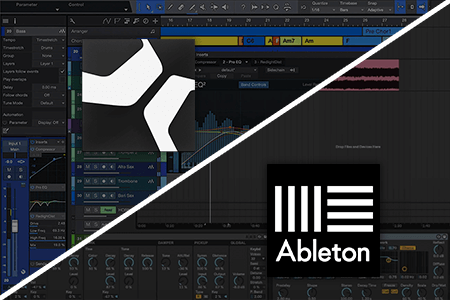

Lots of different instruments can be used inside Live. These can then be controlled with external MIDI control surfaces, helping to give more flexibility and creative direction to a live show. Instruments and effects can also be combined together to form ‘ device racks‘.The global tempo can be fixed, and all the scenes and clips triggered will play at this tempo, keeping everything synchronized in time for smooth and seamless transitioning between different loops and scenes.These scenes can then be triggered alongside individual loops and clips to build up a live performance on the spot. You can have many scenes and many clips loaded into the session before a live performance starts.So for example, a 4-bar drum loop, synth bass, and keyboard loop could be combined to create one scene. Several clips can be combined together to create ‘ scenes‘. Audio and MIDI loops, called ‘ clips‘, are loaded and triggered (played).

The session view is where Ableton Live comes into its own, where live performances can be created. It’s where audio can be recorded and edited, processing and effects can be applied, MIDI tracks can be played and edited, and tracks can be arranged, amongst other things. The arrangement view is where the program looks most like other DAW programs.

Live is organised around two main screens: I love hearing recordings of live performances using Ableton Live, as I know that it’s being created in that very moment, which is an exciting way to listen to music. It means that every performance can be different because you’ll always be able to combine your tracks and loops in new and exciting ways. They can then be ‘remixed’ live, creating brand-new combinations of loops and sounds. It allows DJs to use it for mixing tracks and loops together from other artists as any normal DJ would.īut it also allows musicians to use it for their own live shows – usually by triggering loops and samples of their own material to create new arrangements on the fly.Ī live performance can be built around all of the loops, scenes, and samples you’ve created over time with all your different tracks and productions. The reason for its use in the live arena is due to its loop-based approach to production. But due to the improvements Ableton have made over the years with the different releases and versions, it’s becoming more popular as a studio DAW program as well. Live is best known for its use as a live performance tool for electronic musicians and DJs. Playing around with the live performance side is great fun as well. I love the way it allows you to get your ideas down really quickly and easily, but that it also has all the features you’d want in a good DAW. I find myself using the program more and more these days. On stage for a live performance, due to its loop-based approach.In the studio to compose and arrange your songs and productions.It’s very easy to use and it doesn’t take long to get intothe swing of how it works. Ableton Live is a great program that allows you to create music with a minimum of fuss.


 0 kommentar(er)
0 kommentar(er)
